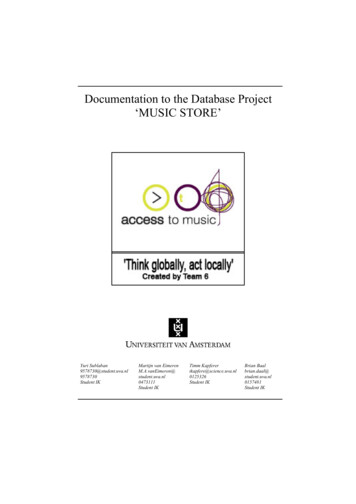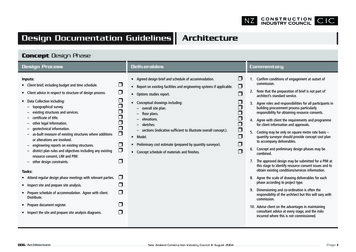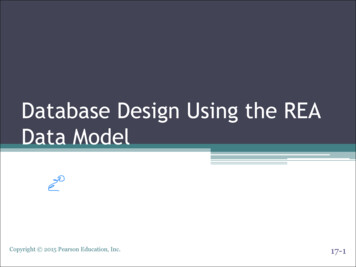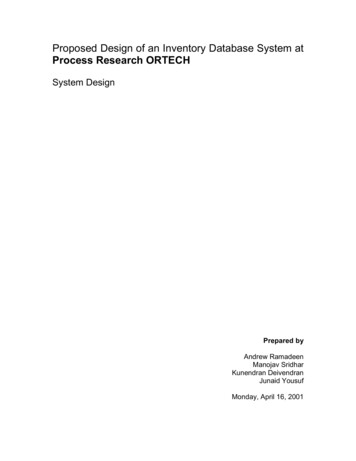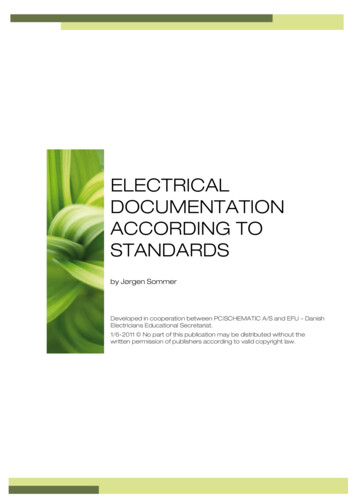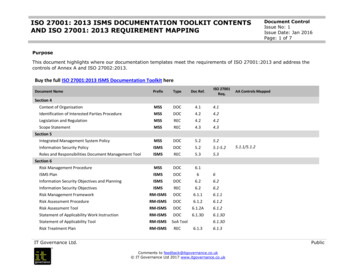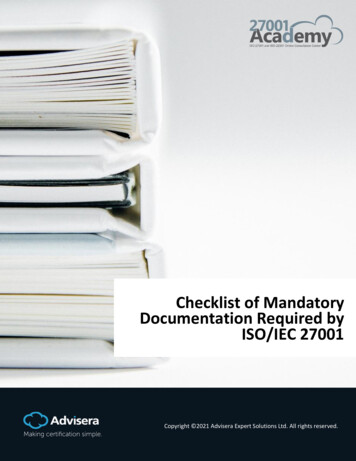
Transcription
CONSERVATION AND SUSTAINABLE USEOF THEMESOAMERICAN BARRIER REEF SYSTEMSPROJECT (MBRS)Belize – Guatemala – Honduras - MexicoDATABASE DESIGN DOCUMENTATIONSAM / MBRSDesign and Implementation of aRegional Environmental Information System (REIS)for the Mesoamerican Barrier Reef Systems ProjectProject Coordinating UnitCoastal Resources Multi-Complex BuildingPrincess Margaret DriveP.O. Box 93Belize City BelizeTel: (501) 223-3895; 223-4561Fax: (501) 223-4513Email: mbrs@btl.netWebsite: http://www.mbrs.org.bz
CONSERVATION AND SUSTAINABLE USE OF THE MESOAMERICAN BARRIER REEF SYSTEM (MBRS)DATABASE DESIGN DOCUMENTATIONDESIGN AND IMPLEMENTATION OF A REGIONAL ENVIRONMENTAL INFORMATION SYSTEM (REIS) FOR THEMESOAMERICAN BARRIER REEF SYSTEMS PROJECTMesoamerican Barrier Reef Systems Project Coordination UnitCoastal Resources Multi-Complex, Fisheries Compound, Princess Margaret DriveP.O. Box 93, Belize City, Belize Central AmericaTel: 501-22-33895/34561Fax: 501-22-34513E-mail: mbrs@btl.net
MBRS Technical Document #20REIS Database Design DocumentationTABLE OF CONTENTSPAGE1.Introduction. 12.Software and Hardware Specifications . 12.1 Software Selection. 12.2 Hardware requirements . 42.2.1 General Specifications. 42.2.2 Detailed Technical Specifications . 43.Database Design. 83.1 Common Tables . 93.1.1 Site Table . 93.1.2 Survey Table . 123.1.3 Transect. 153.1.4 Person . 173.2 Species List. 193.2.1 Species . 193.2.2 Local Name . 203.2.3 Threatened and Endangered. 223.3 Mangroves . 233.3.1 Forest Structure. 243.3.2 Seedling. 25I
MBRS Technical Document #20REIS Database Design Documentation3.3.3 Seedling biomass . 273.3.4 Interstitial Water. 293.3.5 Leaf Litter. 303.3.6 Zonation. 323.4 Coral Reefs . 353.4.1 Manta Tow. 353.4.2 Adult Fish. 383.4.3 Fish Recruitment . 403.4.4 Rover Diver. 413.4.5 Point Intercept . 423.4.6 Benthiclut. 433.4.7 Benthic Coral . 443.5 Seagrasses . 483.5.1 Seagrass Growth. 483.5.2 Seagrass Biomass. 503.5.3 Seagrass Leaf Area Index . 53Appendix A – Data Types. 56II
MBRS Technical Document #20REIS Database Design DocumentationDATABASE DESIGN DOCUMENTATION1.INTRODUCTIONThe Mesoamerican Barrier Reef System (MBRS) is the largest barrier reef system in the Caribbean and the second largest reefsystem in the world. The primary goal of the MBRS project is to enhance protection of these valuable ecosystems. Key to anyprotection strategy is knowledge of the habitats and the various uses of those habitats. Management decisions need to be based oninformation of the system. While there may be many efforts to monitor, study, and manage individual portions of the MBRS, asystem wide overview of the information available is essential for management of the MBRS as a whole unit. Collecting all of thedisparate information and compiling it into one easily accessible database is the goal of the Regional Environmental InformationSystem (REIS). The design of the database is based on the information that is to be collected, or has been collected in the past.The data are stored in PostgreSQL 7.3.2 on a Dell Server running Red Hat Linux Version 8.2. Access to the data will be through aweb interface running on Apache web server and using PHP. This design is to allow easy data entry access and querying toresearchers throughout the 4 countries served by MBRS.The driving philosophy behind the database design was to have an efficient, normalized database that would be easy to maintain andexpand, as well as allow easy data entry and access.-1-
MBRS Technical Document #202.SOFTWARE AND HARDWARE SPECIFICATIONS2.1Software SelectionREIS Database Design DocumentationFollowing reviews of the data that would be entered into the database, and the requirements of retrieving the data several criteriawere identified that need to be met by the database software. The minimum requirements for the software were:1. Must support the relational database model, and some version of the SQL language. This is an industry standard, and asa program that will be spanning several countries and many years adhering to this standard will ensure the longevity andportability of the database. In addition most database administrators are familiar with some form of SQL and relationaldatabases, so training of an administrator will be relatively easy.2. Need to allow multiple users to access tables simultaneously. Since the data is going to be entered by users from 4countries and numerous agencies, it is likely that multiple people will be entering data into the same table at the sametime.3. Allow running of stored SQL scripts. There are many processes that can be automated with stored scripts, to facilitymanagement, updates, editing, and querying of the database. This is especially important if users are accessing the datafrom the internet. Being able to call and run a stored script is far easier and more efficient than trying to code all theinformation into a web form.4. Allow restrictions on the data values entered in columns within a table. Being able to restrict the data to certain ranges orvalues will reduce the possible errors in data entry.5. Allow creation of multiple indexes on a table, as well as unique indexes within a table. Also must be able to create oneindex on multiple columns. Multiple indexes on a table allow faster sorts and queries based on various parameters.Creating a unique index across multiple columns will prevent entering duplicate data.-2-
MBRS Technical Document #20REIS Database Design Documentation6. Allow creation of views on the data. This allows a minimum amount of data to be stored and a virtually unlimited numberof outputs to be created. Views allow display of calculated values, without having to create additional columns in the datatables and have them populated with the calculated values. Having the additional columns can lead to conflicting datawithin one record of a data table. In addition, views allow multiple tables to be joined together to provide a customizedview of the data in the data table.7. Allow inner joins, left outer joins, right outer joins, full outer joins, and multiple joins within a query. The joins are differentways of selecting items from one or more tables, in either a query or a view. The inner join selects only the records thatexist in both tables and matches them up. The left outer join, selects all of the records from the left table and only thematching records from the right table. The right outer join, selects all of the records from the right table and only thematching records from the left table. The full outer join selects all records from both the left and right table and joins therecords that match. The non-matching records are joined with null values.8. Have some method of replication between two servers. Since the data is going to be housed on two servers some sort ofreplication is necessary.9. Allow triggers on the data tables. Triggers will allow predetermined actions to be taken when information is entered,edited, or deleted from a data table. Column data checks are an intrinsic form of triggers.10. Allow data entry from the internet. Most of the data will be entered into the forms from the internet.11. Had to run on a Linux System. The project is running a Linux server, therefore the database program must run on Linux.Based on these requirements the qualified software was examined was Oracle, Informix, Ingres, and PostgreSQL. All of theseproducts met the requirements outlined above. PostgreSQL offered the best price/performance of the qualified software. Based onresearch of the computer literature, PostgreSQL appeared to serve data over the web as fast or nearly as fast as any of the other-3-
MBRS Technical Document #20REIS Database Design Documentationproducts. Also being an open source program there is no upfront cost to acquiring the software. Based on the cost and performancePostgreSQL was chosen as the software to use for this project.Following the selection of the database software and operating system, the web server and server side scripting language defaultedto Apache Web server and PHP. This is the best combination that supports Linux and PostgreSQL.2.2Hardware Requirements2.2.1 General SpecificationsThe database server will be used as a web server and database server for a regional project wi
Network Adapter Intel Pro/100 Dual Port Server Adapter To allow connection to a 100Mbps port on Internet Switch With failover and load balancing support Keyboard Standard Windows PS/2 Keyboard With Keyboard Cable Mouse PS/2 two-button mouse with scroll wheel and With Mouse Cable - 5 - MBRS Technical Document #20 REIS Database Design Documentation Item Description SCSI Drive

